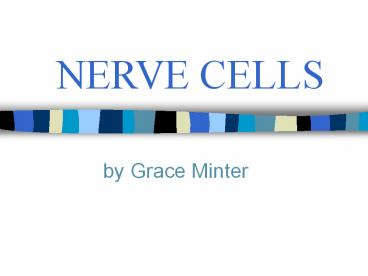NERVE CELLS PowerPoint PPT Presentation
Title: NERVE CELLS
1
NERVE CELLS
- by Grace Minter
2
OVERVIEW
- Definition
- Structure
- Function
3
BASIC DEFINITION
- Nerve Cell (Neuron)
- the structural and functional unit of the nervous
system
4
NEURON STRUCTURE
- All nerve cells contain 4 distinct regions
- 1. Cell body
- 2. Dendrites
- 3. Axon
- 4. Axon terminals
5
STRUCTURE CONTINUED
- CELL BODY
- houses nucleus is site of protein synthesis and
degradation of all neuron proteins and membranes - AXON
- specialized for the conduction of an electric
impulse or action potential away from the
neuronal cell body to axon terminals - AXON TERMINALS
- Send chemical signals to dendrites of other
neurons - DENDRITES
- receive chemical signals from the axon termini of
other neurons convert the signals into electric
impulses for delivery to cell body
6
FUNCTIONAL MECHANISM
- Neurons function through both electric chemical
signaling - An electric potential exist across the plasma
membrane of neurons - the potential is due to the selective
permeability of the membrane to differing ions - resting membrane potential ? 60 mV, negative on
inside because cell pushes large number of K
ions out - An electrical impulse results from the sequential
opening closing of ion channels and is
converted into a chemical signal for message
transmission
7
A CLOSER LOOK
- Transmission of an electrical signal (performed
by axons) - 1. Na channels open influx of Na into cell
causes depolarization of neuronal membrane - 2. Na channels close K channels open
release K ions into extracellular space,
causing hyperpolarization of the membrane - 3. K channels close membrane returns to
resting potential ( 60 mV) - 4. This process spreads across the axon,
generating an electric signal to the axon
terminals
8
A CLOSER LOOK PART II
- Transmission of a chemical signal through
synapses (performed by axon terminal
dendrites) - synapses ? sites where neurons send receive
information from other cells - 1. electrical impulse generated reaches axon
terminals causes the exocytosis of a chemical
neurotransmitter contained within a synaptic
vesicle from the presynaptic cell - 2. Neurotransmitter travels through synaptic
cleft binds to specific receptors on the
dendrites of postsynaptic cell, causing a
change in its permeability to ions
9
BRINGING IT TOGETHER
10
SUMMARY
- NEURON ? functional structural unit of the
nervous system - All neurons are composed of a cell body, axon,
axon terminals, dendrites - Neurons function through both electrical and
chemical signals in order to transmit messages
throughout the body
11
(No Transcript)
12
QUESTIONS

